Latest on ‘Dirty Dancing’ Dilemma
An Open Dialogue Moving
Tentatively Towards Consensus
By Margaret Lipman (December
15, 2006)
After
weeks of debate and discussion, the issue of inappropriate
behavior at GMHS dances may be reaching its conclusion. After
collecting input from both students and faculty, Assistant
Principal Tim Guy and seniors Maggie Jones, Sean Follin,
and Louise Robertson have created a “Dance and Activity Philosophy
Statement,” explaining the purpose of school dances and the
expectations that all students are to fulfill while in attendance. A
list of specific guidelines for chaperones to follow regarding
student conduct is currently in the works and will hopefully
be finished before the next dance, which is tentatively planned
for January 5.
|
For
better or for worse, one of the trends currently in vogue
is the “bumping and grinding” style of dancing that has been
popularized in countless music videos and has now become
a staple of dances at George Mason. In
the past, the school administration has cautioned students
against inappropriate behavior at dances by posting signs
warning students to dance in a way that they would not be
embarrassed for their grandparents to see. Those
signs have not been posted at Prom or Homecoming, however,
because, according to Guy, these formal dances “do not usually
have a ‘club’ atmosphere.” However, Mr. Guy said, in the last few years,
chaperones have noticed more and more questionable behavior
at even these formal events and have become increasingly
reluctant to supervise school dances.
|
|
Assistant
Principal Tim Guy, left, discusses proposals related to appropriate
behavior at student dances with committee members Maggie
Jones, Sean Follin, and Louise
Robertson. Together they have fashioned a “Dance and Activity
Philosophy Statement.” (Photo by Margaret Lipman)
|
“This issue has been growing and it has come to
a turning point,” said Mr. Guy. That “turning
point” came at Homecoming this year, when a record number of students,
540, attended the dance, creating an atmosphere that both students
and faculty found very crowded, though they lauded the large turnout. In the days following Homecoming, several parents
contacted the school administration to express concerns that their
children had felt pressured to dance in a way in which they were not
comfortable.
“Why would we allow something on a Friday
night in the cafeteria that we wouldn’t allow during the day?” asked
Mr. Guy during a meeting of TA representatives last month, raising
a point that received both empathetic and indignant responses from
the students. Yet the administration made it clear that
before the next school-sponsored dance can occur, an agreement needs
to be reached in order to set parameters for what can be considered
appropriate. Mr. Guy stressed that he was more than willing
to work with students, faculty, and parents to reach a solution that
everyone can live with. “Something’s
got to change,” he told the TA reps, “but how it changes is up to you.”
It should be known that contrary to popular
belief, the presence of eighth graders at high school dances is not
the issue. The administration wants to ease the concerns
of parents and faculty about what occurs at school dances and ensure
that all students are able to have fun and enjoy themselves in a way
that does not compromise the comfort of others. This
will also include discussions and deliberations about a situation raised
in numerous conversations about the dances in TA’s. Many students mentioned the prevalence of alcohol
use prior to these school events, a new issue that has certainly caught
the attention of the administration.
So far, two additional meetings have
been held on the subject of student conduct, one of which was attended
by faculty members and the other open to all students. Most
recently, seniors Louise Robertson, Maggie Jones, and Sean Follin met
with members of the administration to draft a “Dance and Activity Philosophy
Statement,” which outlines the school’s purpose and intent for sponsoring
dances in the first place. Although
it has yet to be finalized, the statement cites promoting “unity, spirit,
and a positive school climate” and providing students with opportunities
for social growth as the goals of all GMHS dances. Also, the dances are intended to provide student
organizers with leadership experience and create “a welcoming and safe
environment for all.” Yet although
the dances are undoubtedly intended to be fun and enjoyable, students
are expected “to demonstrate respect, responsibility, and integrity.” The philosophy statement was modeled on the
Honor Code in that it reminds students of the responsibilities they
are expected to fulfill.
A list of guidelines for chaperones is
currently being written, detailing the specific behaviors that are
clearly “over the line” and will not be permitted at school events. Mr.
Guy hopes that Robertson, Jones, and Follin will
collaborate with other student groups such as the Mustang Ambassadors,
the SCA, and the SADD (Students Against Destructive Decisions) Club
to write those guidelines. He
admits that this is a complex issue that requires a very frank (if
somewhat uncomfortable) discussion, but hopes that students and faculty
can come to a consensus if the next dance (scheduled for January 5,
following a home basketball game) is to have enough chaperones and
boast a successful turnout.


